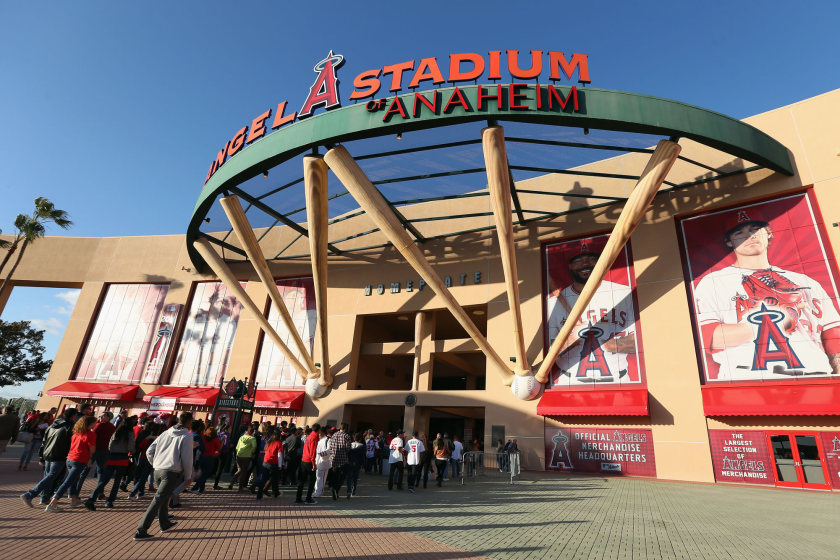Bottled water suckers!
- Share via
Some years back, during a break in the criminal case against her, the Beverly Hills madam, Alex Adams -- the more circumspect predecessor to Hollywood madam Heidi Fleiss -- went padding down the courthouse hallway. She carried her empty bottle of Evian water, and she refilled it at a public drinking fountain.
It struck me as funny when I watched her do it then -- Evian pretensions and tap-water realities.
It’s still funny now, for different reasons. The H2O in at least one-quarter of the billions of bottles of water this country swigs down every year comes out of the same public reservoirs that send water to every tap from public drinking fountains to your bathroom sink.
Now Aquafina, the biggest-selling bottled water in the country, bottled by Pepsi, has been outed. The water in those pretty, swirly-topped bottles with the pure blue mountain logo comes from the same sources as the humble -- and cheap -- tap water in Fresno and Wichita and Detroit and other cities that are nowhere close to pure blue mountains.
Dasani water, bottled by Coca-Cola, has already been busted for its tap-water pedigree from pristine locales such as Queens, N.Y., but it’s still this nation’s second-best-selling water. (Britons laughed Dasani off the shelves; its marketing campaign couldn’t stand up to mocking comparisons to a BBC sitcom character who scammed customers by repackaging tap water as a fancy brand.)
Crystal Geyser water comes out of the same Owens Valley well that the Department of Water and Power draws from. Yosemite Water doesn’t come from Yosemite Valley -- it’s from L.A.’s Highland Park, where there’s a street named Yosemite. Some of the DWP’s biggest water customers are. . . bottled water companies.
Of course, the bottlers purify already drinkable water, but slap a filter on your spigot and yours will be purified too.
Tap water often comes from the same source as the bottled stuff. It’s cheaper than the bottled stuff. It may be safer than the bottled stuff -- big city tap water is tested for some bacteria at least 100 times a month; the FDA requires bottlers to test just once a week.
Which is why, in the words of the Economist, the success of bottled water is “one of capitalism’s greatest mysteries.” In the words of me, where’s the mystery? We’re suckers.
We drink more bottled water than we do coffee or milk. (Sodas are more popular, but for how long, after last week’s news that even one soft drink a day can add 50% to the risk that you’ll get a condition that’s a precursor to heart disease and diabetes.)
About 30 years ago, we each drank about six quarts of bottled water a year in Southern California. Now it’s nearly 29 gallons. If earthquake rubble buried us in an instant, so many of us would be death-gripping water bottles that future archaeologists would conclude they were religious talismans.
You can get at least 450 gallons of L.A. tap water for the $1.35 you’d pay for 20 ounces of Aquafina. Turn that around, and 20 ounces of L.A. tap water costs about one-twentieth of a cent.
Would you pay $5 for a gallon of gas in a pretty container if you could get a plain-wrap gallon for half a penny? When it comes to water, that’s pretty much what we do.
And we do it in part because public water has a worse image than Michael Vick. Public water contamination in places like Milwaukee and Washington crowds out memories of the benzene that turned up in Perrier samples years ago. And oh, that “eeesh” factor from tap water and public drinking fountains.
If you’re a Third World immigrant to the U.S. you may buy bottled water, a habit from homelands where local water was undrinkable. If you’re scared of terrorism, bottled water just feels safer. If you’re in a rush, unless you’ve got a faucet in your dashboard, it’s convenient. And if you don’t have a filter, it may taste a little better.
Still, I think people are getting thirsty -- for something different.
After The Times pointed out that L.A. was spending half a million bucks a year to get people to drink DWP water at the same time it was buying the bottled stuff for some city offices, the mayor put the kibosh on outside H2O. Ann Arbor and Salt Lake City are pushing the local drink. San Francisco Mayor Gavin Newsom is too. Chic restaurants are pouring eau de tap as the house brand. Enviros are crusading against mountains of un-recycled plastic water bottles.
And how healthy can that bottle of European spring water really be, if the best reason to drink it is to wash away the taste from the jet-fuel pollutants that were created to get it to your table?
More to Read
Inside the business of entertainment
The Wide Shot brings you news, analysis and insights on everything from streaming wars to production — and what it all means for the future.
You may occasionally receive promotional content from the Los Angeles Times.











